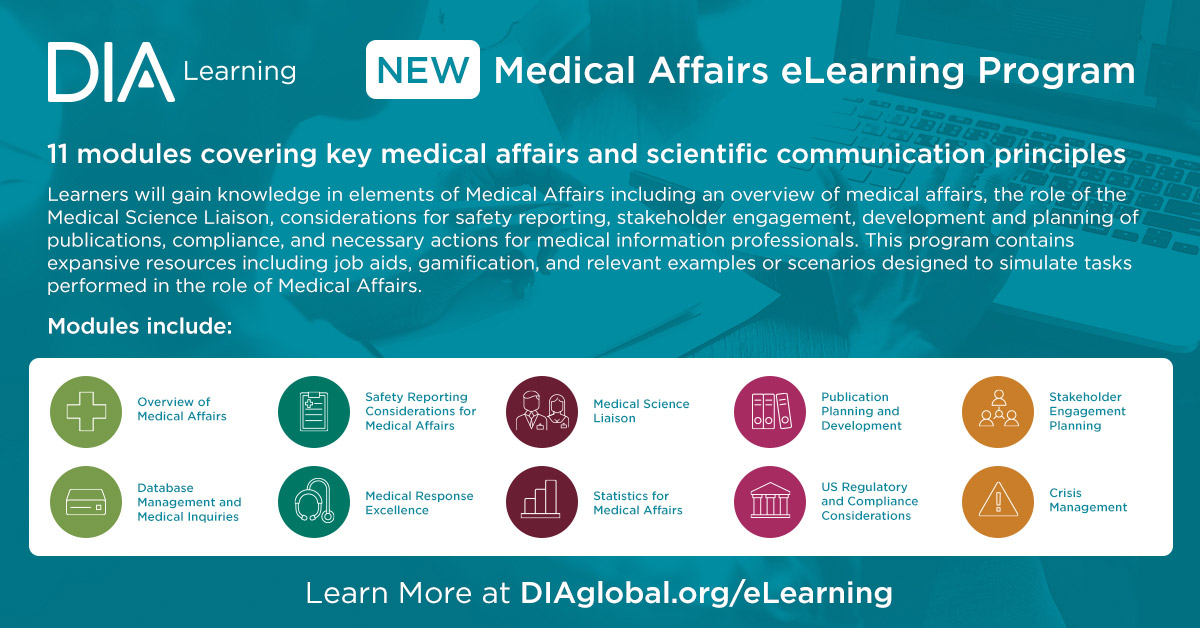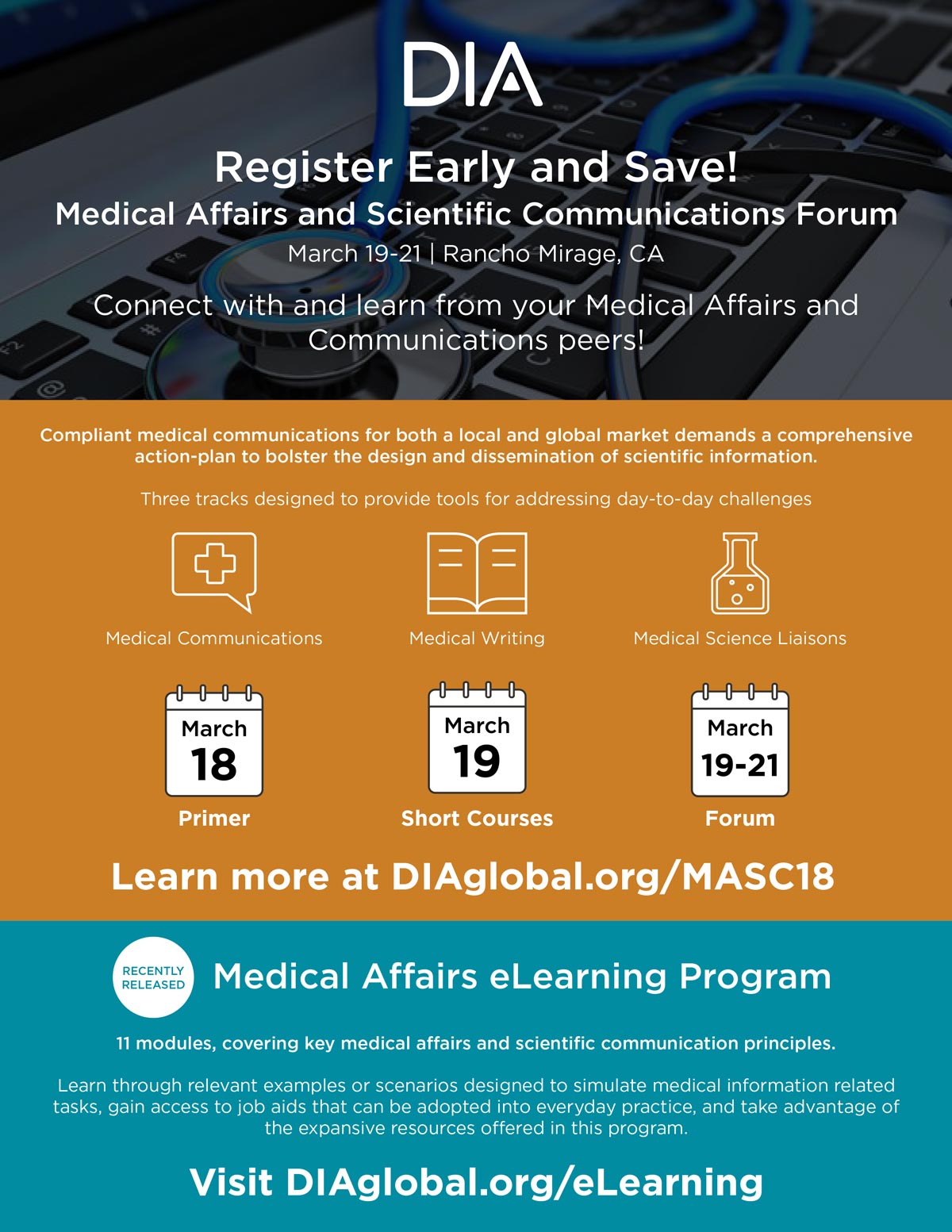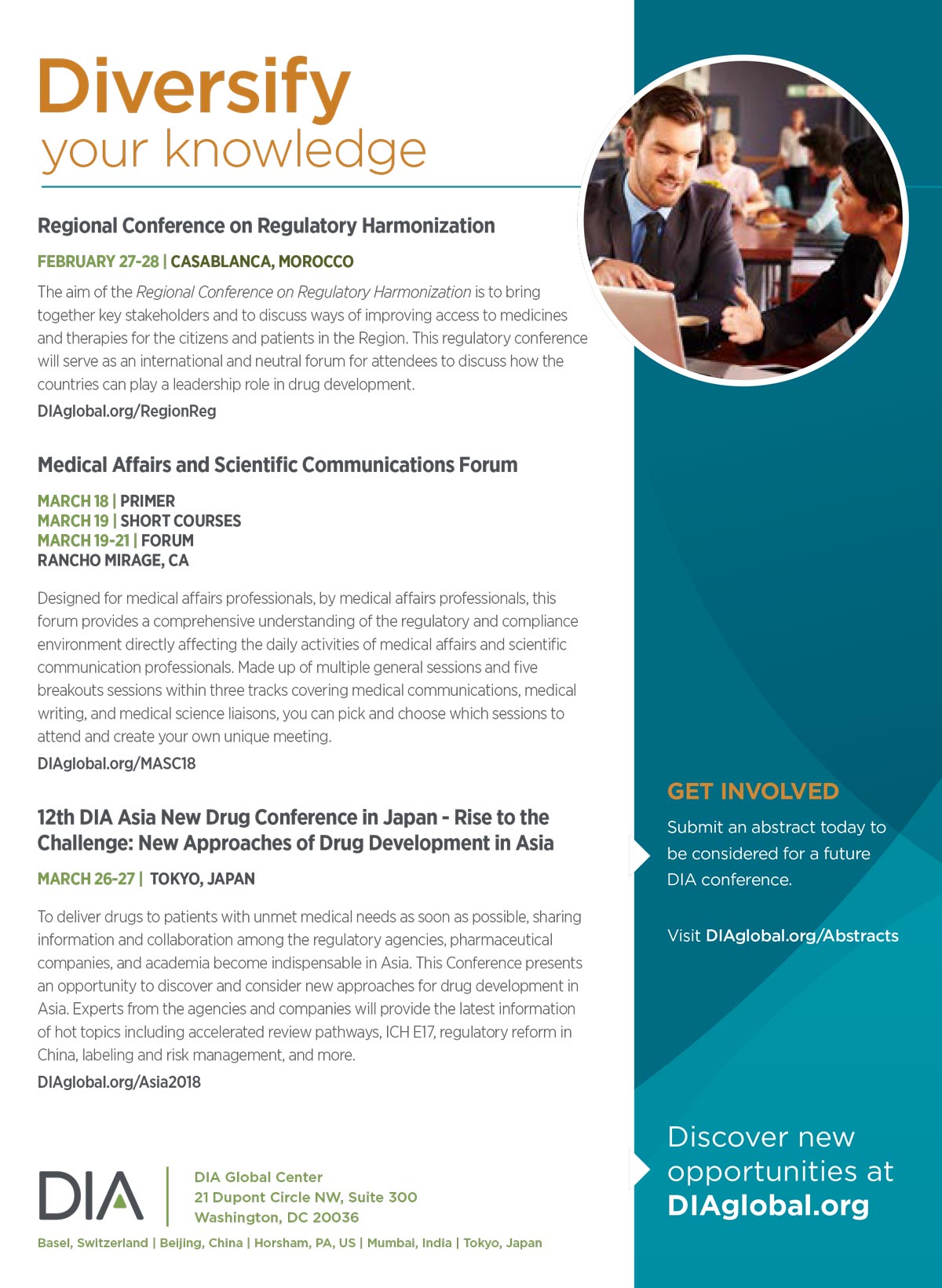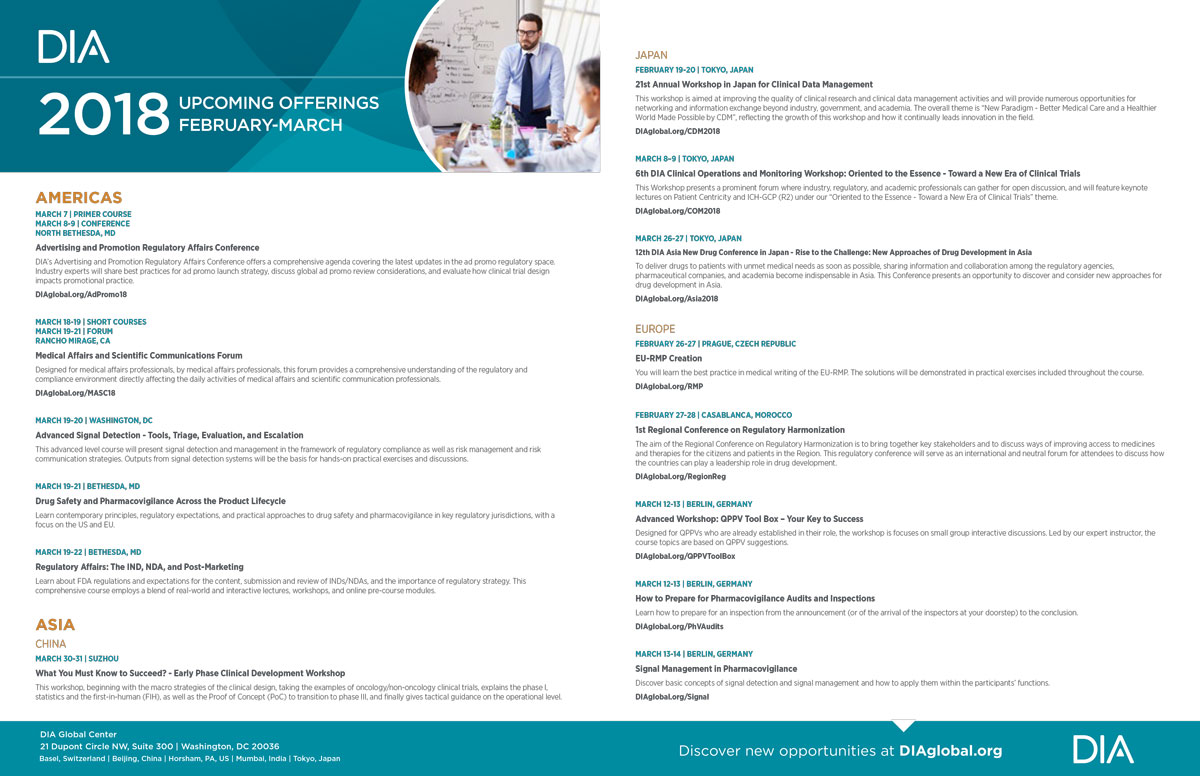February 2018 Global Forum
Table of Contents
Translational Science
A pilot precision medicine cancer immunotherapy using tissue protein expression and blood plasma antibody profiles
Regulatory Science
Kyoto Summit of Heads of Medicines Regulatory Agencies and ICMRA
Regional Reports
Five Principles, Visible Progress, and a Long Way Ahead
Executive Leadership
We are DIA
Career Column
Community Spotlight
Subscribe
Love Global Forum‘s new online format? Subscribe today and never miss an issue.
Executive Leadership | Global Chief Executive and Board Chair Message
To Our Readers
The Road to Morocco

John A. Roberts
Chair, DIA Board of Directors

Barbara Lopez Kunz
Global Chief Executive, DIA
e will soon come together in Basel for DIA Europe 2018 (April 17-19), our annual flagship gathering in Europe. With Brexit on everyone’s mind and European healthcare systems facing potential widespread changes (including EMA’s move to Amsterdam), this meeting could not come at a better time.
As we invite and amplify voices from the entire healthcare product development landscape, we will debate, learn, and grow – individually and as a community. In Basel we will also celebrate DIA’s 30 years of driving collective insights to action. Please join us in April!
World Rare Disease Day is February 28. No one celebrates disease; the objective of this Day is to raise awareness among regulatory authorities, researchers, and all other healthcare professionals about disease and its impact on patients’ lives. The HIV/AIDS movement in the early 1980s was the first of its kind – it put AIDS on the international agenda and compelled US policy makers and others to allow AIDS drugs to be more accessible. But, there have been many other “firsts,” some perhaps less glamorous but no less important: The first parent brave enough to question their child’s healthcare provider about a treatment plan that just doesn’t seem right; the first patient brave enough to enroll in a clinical trial for a promising new therapy for an illness with no current treatments; the first person to act upon the realization that the best way to begin meeting patient needs is to ask patients what they need; and the first regulatory agency to realize that there is strength in collaborating with their global counterparts.
Executive Leadership | Editor’s Message
To Our Readers
The Need for Speed

Alberto Grignolo
Editor
Fellow of DIA
dozen years ago I visited the office of a world-renowned oncologist. As I waited for him to arrive, I glanced at the numerous awards, recognitions, and accolades displayed in his spacious office; all very impressive.
But one particular object drew my attention and remains etched in my memory to this day: a small, simple, lucite-encased white sign displayed prominently on his desk that read, “For a cancer patient, WAIT is a four-letter word.”
In American culture, a four-letter word is an obscenity, an insult not to be used in polite company. In this case, the clear message was that “waiting” is an insulting and unacceptable call to inaction for cancer patients and, by extension, for many other people affected by life-threatening diseases. When your life’s clock is rapidly counting down to zero, waiting patiently and endlessly for a cure is not an attractive option.
In rising numbers, regulators understand this and are taking action. On September 24, 2002, an editorial in The Wall Street Journal carried the headline “FDA to Patients: Drop Dead,” and accused FDA of being a bureaucratic maze out of which few cancer therapies emerged, and too slowly. Fast forward to the 2011-2017 timeframe, when FDA approved 69 new drugs for various cancer indications; in 2017 alone, FDA approved 15 therapies for cancer and cleared 46 new drugs overall–the highest total since 1996. The average time to approval of cancer drugs in this six-year period was six to seven months. The median time to approval of all drugs in 2017 was a historically-low eight months. FDA to Patients: We Want You Alive and Well.
Editorial Board
Content stream editors
Translational science
Gary Kelloff US National Institutes of Health
David Parkinson ESSA Pharma, Inc.
regulatory science
Yoshiaki Uyama Pharmaceuticals and Medical Devices Agency (PMDA)
Adora Ndu BioMarin Pharmaceutical, Inc.
Patient engagement
Deborah Collyar Patient Advocates In Research (PAIR)
Lode Dewulf Corvalus and Doctors of the World
Value & access
Edith Frénoy European Federation of Pharmaceutical Industries and Associations (EFPIA)
Sean Tunis Center for Medical Technology Policy (CMTP)
Editorial Staff
Alberto Grignolo, Editor PAREXEL International
Ranjini Prithviraj, Senior Managing Editor, Associate Director DIA Publications
Sandra Blumenrath, Science Writer DIA Publications
Chris M. Slawecki, Senior Copywriter DIA Publications
Regional Editors
AFRICA
David Mukanga Bill and Melinda Gates Foundation
ASEAN
Silke Vogel Duke-National University of Singapore Graduate Medical School
AUSTRALIA/NEW ZEALAND
Richard Day University of New South Wales, Medicine, St Vincent’s Hospital
CANADA
Judith Glennie JL Glennie Consulting, Inc.
Megan Bettle Health Canada
CENTRAL AND SOUTH AMERICA
Jaime Oliveira Bayer S/A
CHINA
Ling Su Shenyang Pharmaceutical University, Lilly Asia Ventures
EUROPE
John Lisman Lisman Legal Life Sciences
INDIA
J. Vijay Venkatraman Oviya MedSafe
JAPAN
Junichi Nishino Novartis Pharma K.K.
US
Ann Meeker-O’Connell Johnson & Johnson Quality and Compliance
DIA Membership
Bringing together stakeholders for the betterment of global health care.
Translational Science
Advancing Cancer Immunotherapy with Proteomics


Introduction by Gary J. Kelloff and David Parkinson, DIA Global Forum Translational Science Content Editors
ver the past decade, successes in precision medicine have been built on the backbone of scientific advances in genomics. However, more than good genomic science is needed. In fact, understanding the effects genomic alterations have on cell function is equally or more important.
One way of measuring this functionality is evaluation of genome-driven protein expression (proteogenomics), but this effort has been hampered by irreproducible, non-quantifiable assays and a lack of clinically practical assays. Two efforts to address these challenges are described in this month’s translational science overview:
- The National Cancer Institute’s Clinical Proteomic Tumor Analysis Consortium’s program to develop robust multiplex protein assays using multiple reaction monitoring (MRM) mass spectroscopy, which measures multiple immunomodulatory factors simultaneously
- The use of nucleic acid programmable protein arrays (NAPPA) technology to evaluate the effects of therapy on protein expression in individual patients treated with immunotherapy, an effort that is pertinent to predictive medicine in oncology and currently a high priority in clinical cancer research.
Regulatory Science
Innovation, Cooperation, Efficiency: Kyoto Summit of Heads of Medicines Regulatory Agencies and ICMRA
Written By
Nobumasa Nakashima
Office Director for International Regulatory Affairs, Ministry of Health, Labour and Welfare (MHLW); Executive Committee Chair, Summit of Heads of Medicines Regulatory Agencies Symposium
Edited By
Junichi Nishino
Global Forum
Japan Regional Editor
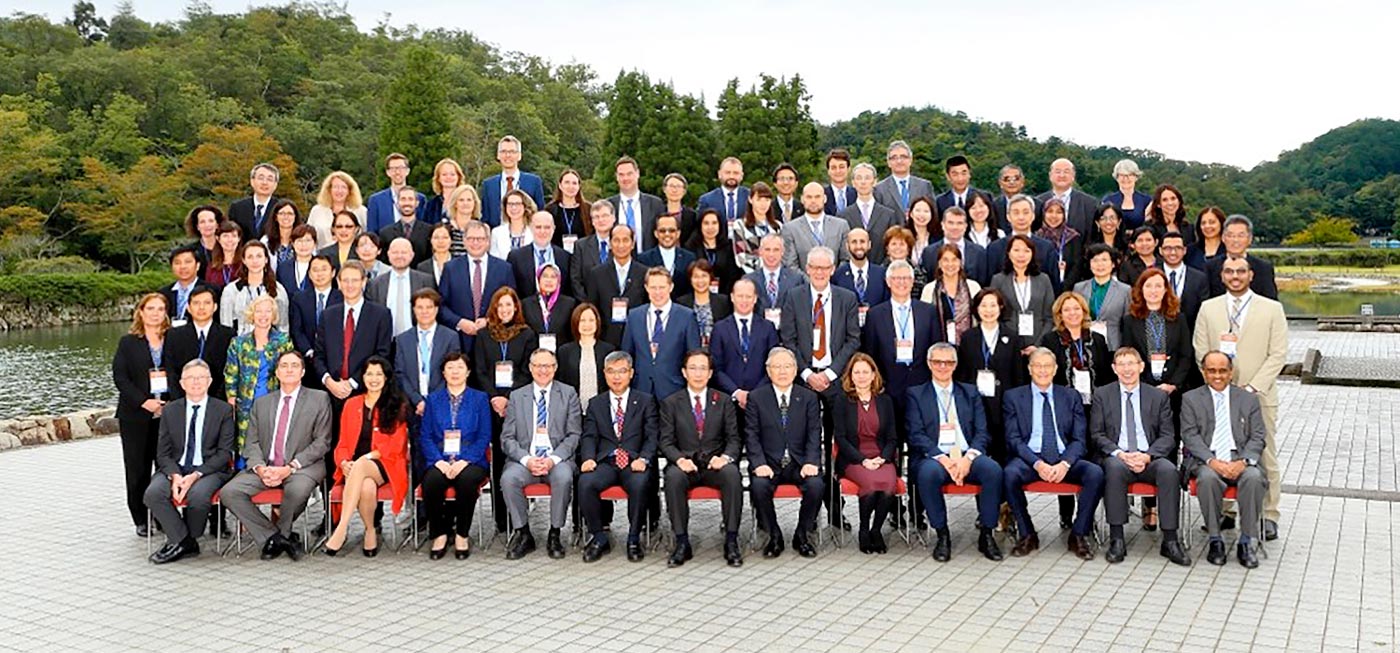
Leadership from the public Summit Symposium.
n October 2017, the 12th Summit of Heads of Medicines Regulatory Agencies and the International Coalition of Medicines Regulatory Authorities (ICMRA) convened in Kyoto, with regulatory authority representatives from 29 countries and regions, including China, Europe, and the US, attending.
The Summit was initiated in 2006 to facilitate an exchange of opinions among the regulatory agencies from 23 countries and regions around the world. This was the first Summit to be held in Japan. Since 2012, ICMRA has branched off from the Summit to conduct international cooperation projects, and has created supply chain, post-marketing safety measures, and crisis management working committees. The next combined ICMRA Summit will be held in the US.
Regional Reports
West Africa Medicines Regulatory Harmonization (MRH) Program Launched
David Mukanga
Global Forum Africa Regional Editor

Left to right: Moderator from Devex and representatives of NEPAD, AUC, WHO, WB, and BMGF
very two years, the International Federation of Pharmaceutical Manufacturers & Associations (IFPMA) and the New Partnership for Africa’s Development (NEPAD) host the Africa Regulators’ Biennial Scientific Conference on Medical Products Regulation.
In November 2017, all conference roads led to Accra Ghana for a conference co-organized with the Ghana FDA, the Economic Community of West African States (ECOWAS), the World Health Organization (WHO), the African Union (AU), and the Federation of African Pharmaceutical Manufacturers Associations (FAPMA) under the theme Sustaining the Momentum for Regulatory Harmonization in Africa.
Regional Reports
New ACTA’s Unexpectedly Positive Global Impact
Richard Day
DIA Fellow
Global Forum
Australia/New Zealand Regional Editor
he recently established Australian Clinical Trials Alliance (ACTA) is having an unexpectedly positive impact in Australia and globally.
ACTA has the very laudable aim of promoting “effective and cost‐effective healthcare in Australia through investigator‐initiated clinical trials and clinical quality registries that generate evidence to support decisions made by health practitioners, policy‐makers, and consumers.” The rationale is compelling, namely “Many clinical decisions in medicine are still based on either low quality evidence or no relevant evidence at all.” Further, ACTA argues that “public good,” “investigator-initiated” clinical trials are needed to address important gaps in our knowledge.
Regional Reports
Significant Change Coming to Patented Medicine Pricing in Canada
Judith Glennie
Global Forum
Canada Regional Editor
hat’s the issue? As noted in the September 2017 Global Forum, the Federal Minister of Health and the Patented Medicine Prices Review Board (PMPRB) have been examining potential changes to the regulations that govern how the PMPRB assesses patented drug prices.
Details of proposed changes to the Patented Medicines Regulations were made public via the Canada Gazette Part I (CGI) in late 2017, with the comment period closing in mid-February 2018 and a proposed coming-into-force date of January 1, 2019. The potential implications of these changes for the Canadian pharmaceutical policy environment—and beyond—may prove to be profound.
Regional Reports
Drug Regulation in Mexico: Five Principles, Visible Progress and a Long Way Ahead
Jaime Oliveira
Global Forum
Central/South America Regional Editor
exico is the second largest economy in Latin America and the country’s medicines market ranks among the world’s twenty most important. Mexico’s national drug regulatory authority, COFEPRIS, is one of the best equipped agencies in Latin America, and was classified in 2012 as a national regulatory authority of regional reference by the Pan-American Health Organization.
In March 2016, COFEPRIS launched the “5 principles and 15 actions for protection against health risks” program, which established the regulatory authority’s priority areas of attention. The five principles, to which the fifteen actions are linked, encompass the areas of ethics, expertise, efficiency, competitiveness, and institutional global approach. The ethics principle involves transparency and access to information by the Mexican population to increase confidence in the agency. The expertise principle targets improvements in the regulatory environment for clinical trials and strengthening pharmacovigilance activities in the country.
We Are DIA | Podcasts
Listen & Learn
Have You Heard? DIA Podcasts
DIA podcasts offer listeners a unique opportunity to hear from leaders in healthcare product development, regulation, and patient advocacy. Subscribe to our Driving Ideas to Action iTunes podcast channel to stay connected!
Our Most Recent Podcasts

Advertising & Promotion: What You Can (and Can’t) Say
Wayne Pines, President for Regulatory Services and Healthcare, APCO Worldwide

Multiple Channels Can Share “One Medical Voice”
Poonam A. Bordoloi, Associate Director, Strategic Medical Communications & Innovation, Celgene Corporation
David Bowers, Medical Communications Director, PPD

Rules for Successful Patient-Industry Engagement
Dr. Jeffrey Sherman, Chief Medical Officer / Executive Vice President, Horizon Pharmaceuticals; DIA liaison to the Clinical Trials Transformation Initiative
Ron Bartek, Co-Founder and President, Friedreich’s Ataxia Research Alliance
We Are DIA
Community Spotlight
Preeminent Community of Project Management Practice

he DIA Project Management Community creates opportunities for connection and knowledge sharing for project management (PM), portfolio management, and strategic operations professionals across the healthcare ecosystem with the goal of being the preeminent community of practice for these multidisciplinary project managers.
We strive to enable non-competitive information sharing to drive innovation in development strategy and execution for healthcare products, technologies, and services.
We Are DIA
Career Column
Selecting a Risk-Based Monitoring Vendor: Ensure Compliance

isk-based monitoring (RBM) has received significant endorsement, not only through major industry consortia such as TransCelerate BioPharma, but through key guidances issued by the ICH, FDA, and EMA.
The November 2016 ICH E6 RS GCP guideline gave significant weight to RBM and the responsibilities of sponsors, and also requires investigators to take a greater role in study design and risk management and monitoring, while the FDA guidance describes RBM, as “focused on the risks to the most critical data elements and processes necessary to achieve the study objectives.”
Thus, while industry is still in the process of determining its return on investment (ROI) in RBM, there is a somewhat rapid desire in industry to adopt RBM methodology, even from previous naysayers. Pharmaceutical companies often lack core RBM expertise and are therefore frequently partnering with vendors to drive their RBM strategy. Because RBM methodology is fundamentally data-driven, it’s crucial for chosen vendors to have a clear understanding of regulations impacting these data.
We Are DIA
Career Column
The Interview Process: A Peer Guide for Students

ood evening, my name is Sara.” No, that’s not good. “Hello.” Let me try again. “Hi, my name is Sara, and I am sincerely interested in the Medical Affairs position at your company.” No, I don’t like the sound of that.
Maybe if I smile while saying it? “This job seems like the perfect match for my abilities and interests.” Don’t forget to make eye contact. Sara stands staring into the mirror. Proper interview performance is an art in itself. As always, practice makes perfect. Sara isn’t just worried about what she says. She is taking several measures to perfect the art of confident professional presentation, including social skills and a professional presence.
Through our experiences as young aspiring professionals, we have gathered some recommendations and research findings that we have found helpful and which may guide you to a more successful interview.

Thanks for reading our February 2018 Issue!




